
An Essential Guide to Comparing Prep Table Embalming Options
The Essential Equipment: Understanding Prep Table Embalming
Prep table embalming refers to the process of preserving and preparing deceased individuals using specialized tables designed for efficient fluid drainage, proper body positioning, and optimal working conditions. If you're looking for quick information about embalming prep tables, here's what you need to know:
| Prep Table Type | Weight Capacity | Price Range | Key Features |
|---|---|---|---|
| Standard Hydraulic | 650-1,000 lbs | $5,000-$8,000 | Height adjustable (30"-38"), convex top, deep side troughs |
| Folding | 600 lbs | $659-$3,000 | Portable, easy storage, aluminum or stainless steel |
| Multi-Height | 650-800 lbs | $3,500-$7,000 | One-hand release, locking casters, 3" trough |
| Bariatric/Oversized | 1,000+ lbs | $8,000-$12,000 | Extra width, reinforced frame, heavy-duty casters |
| Autopsy/Specialized | 454-600 lbs | $10,000-$19,995 | Perforated surface, integrated scales, dissection features |
The right prep table serves as the foundation of effective embalming, combining ergonomic design with practical features that facilitate the careful work of preparing the deceased. Modern tables feature convex stainless steel surfaces that direct fluids away from the body into deep side troughs, preventing pooling and ensuring proper drainage through dedicated stems.
I'm Mortuary Cooler, a national-level supplier of mortuary equipment with extensive experience helping funeral professionals select and implement prep table embalming solutions that meet their specific needs and budget requirements. My team has equipped hundreds of preparation rooms across the country with customized tables designed for optimal workflow and compliance with industry standards.
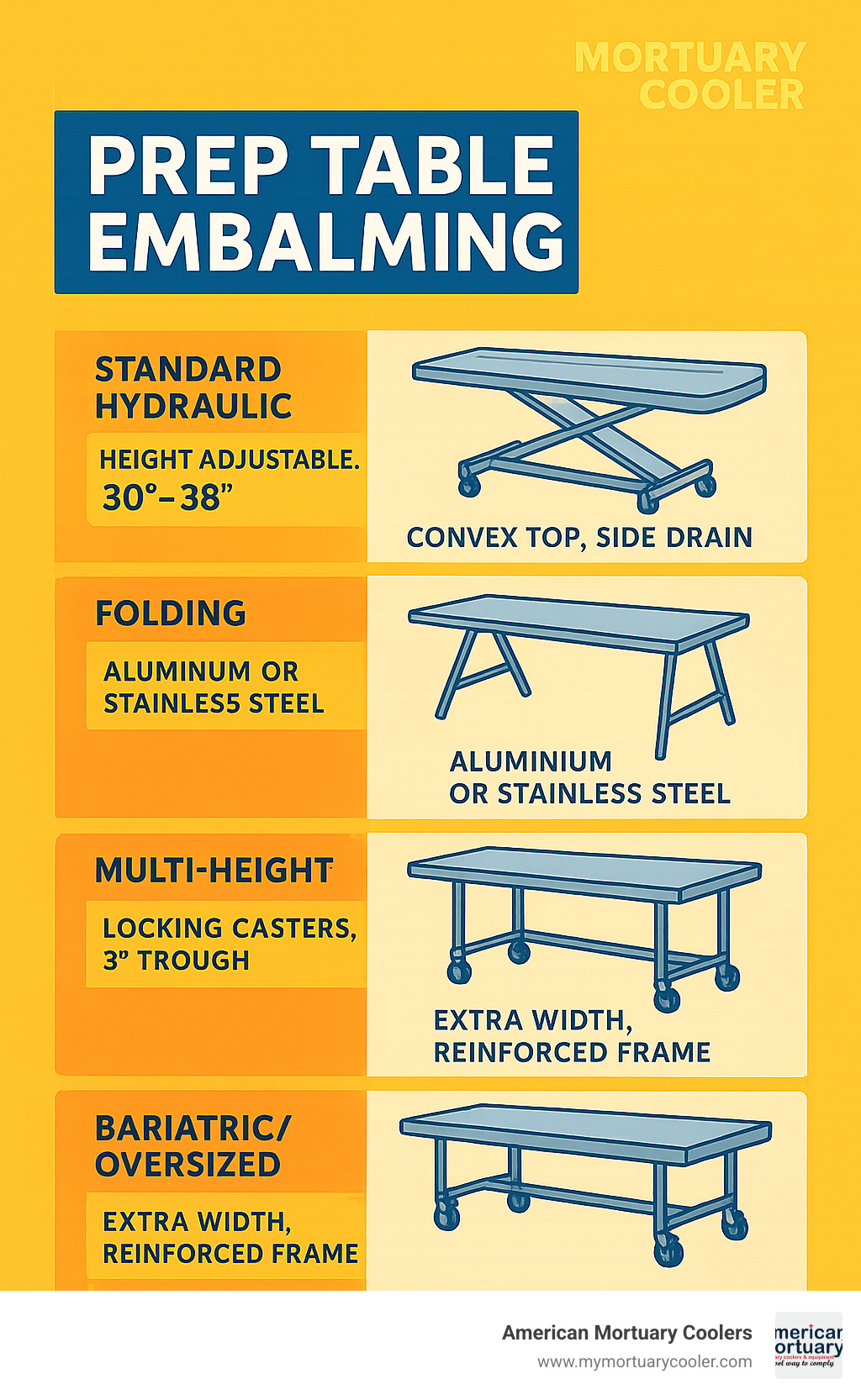
*Prep Table Embalming * word roundup:
Prep Table Embalming Fundamentals
When you step into a well-equipped preparation room, the embalming table stands as the centerpiece of the entire operation. Prep table embalming isn't just a procedure—it's the heart of funeral service, requiring thoughtfully designed equipment that supports the dignified care of those who have passed.
A quality prep table does so much more than provide a surface. It creates the foundation for proper care by offering a stable, sanitary platform for positioning, facilitating drainage of fluids, reducing physical strain through ergonomic design, safely supporting various body types, and enabling proper positioning for vascular access during the embalming process.
Modern embalming tables feature a gentle 1-2 degree slope—subtle to the eye but essential for directing fluids toward collection troughs. While standard tables typically support up to 650 pounds, our specialized bariatric models at American Mortuary Coolers can safely accommodate 1,000 pounds or more, ensuring every deceased individual receives the same level of care regardless of size.
OSHA doesn't take preparation room safety lightly, and neither do we. Regulations require non-porous, thoroughly sanitizable materials, which is why 304 stainless steel has become the industry gold standard. During Prep table embalming, universal precautions must be followed, including proper fluid management systems that prevent splashing and keep potentially infectious materials contained.
What is Prep Table Embalming?
Prep table embalming refers specifically to the arterial and cavity procedures performed on a table designed for this purpose. The process unfolds like a carefully choreographed sequence: positioning the body on the table's convex surface, making precise incisions to access major blood vessels, introducing preservative fluids through the arterial system, aspirating body cavities and injecting cavity fluid, and performing any necessary restorative work.
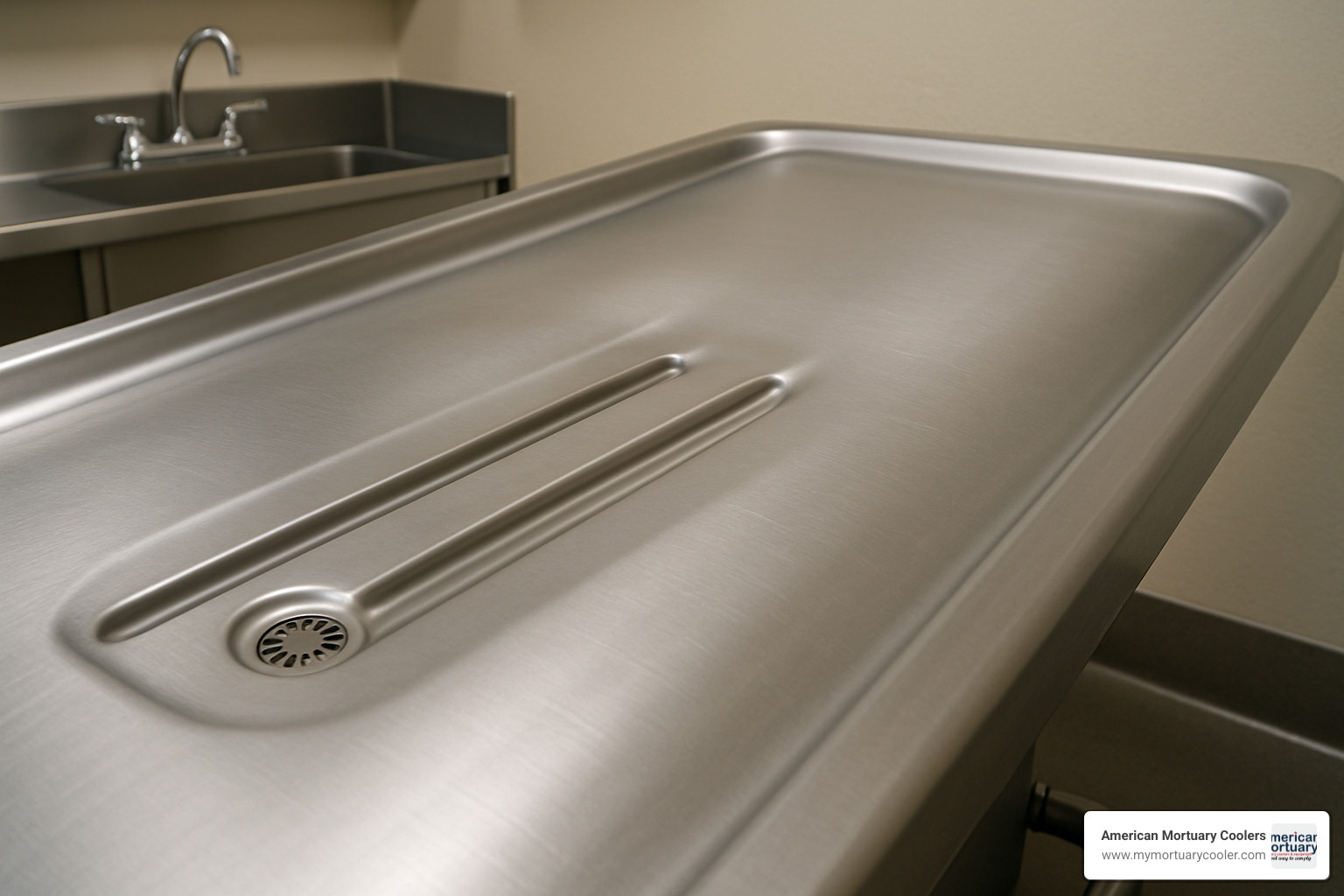
The convex design you see in modern tables isn't just about aesthetics—it serves a crucial practical purpose. At American Mortuary Coolers, we've engineered our tables with slightly raised centers that naturally guide fluids toward the side troughs. This seemingly simple design feature prevents pooling that could lead to tissue discoloration and compromised preservation, while minimizing the risk of cross-contamination during the embalming process.
The Evolution of Prep Table Embalming Technology
We've come a long way from the simple wooden "cooling boards" of the 19th century. If our funeral ancestors could see today's prep table embalming technology, they'd be amazed at the innovations that now support this sacred work.
Modern tables now incorporate hydraulic pump systems that adjust height from 30" to 38" with just the tap of a foot pedal—saving backs and preventing injuries. Multi-height frames with one-hand release mechanisms allow for quick positioning adjustments, while reinforced bariatric structures safely accommodate larger individuals with dignity and respect.
The surfaces themselves have evolved too, with specialized designs for specific needs—perforated tops for autopsy work and solid tops for standard embalming procedures.
One of the most promising recent innovations is the Soft-Prep method, which uses less than 1% formaldehyde concentration. This gentler approach reduces chemical exposure for funeral professionals (something we all appreciate!) while creating a more natural tissue appearance and flexibility. It's particularly valuable in teaching institutions and medical training facilities where presentation matters.
These technological advancements complement the fundamental techniques outlined in the 4 Tips to Perform Embalming Successfully, which emphasize proper fluid distribution, adequate drainage, appropriate chemical selection, and meticulous attention to detail—all supported by thoughtfully designed equipment.
At American Mortuary Coolers, we've watched this evolution closely, incorporating the best innovations into our designs while maintaining the reliability and durability funeral professionals depend on every day.
Comparing Embalming Prep Table Types
When you're in the market for Prep Table Embalming equipment, the choices can feel overwhelming. Trust me, I've helped hundreds of funeral professionals find their perfect match, and I know each prep room has its own unique needs.
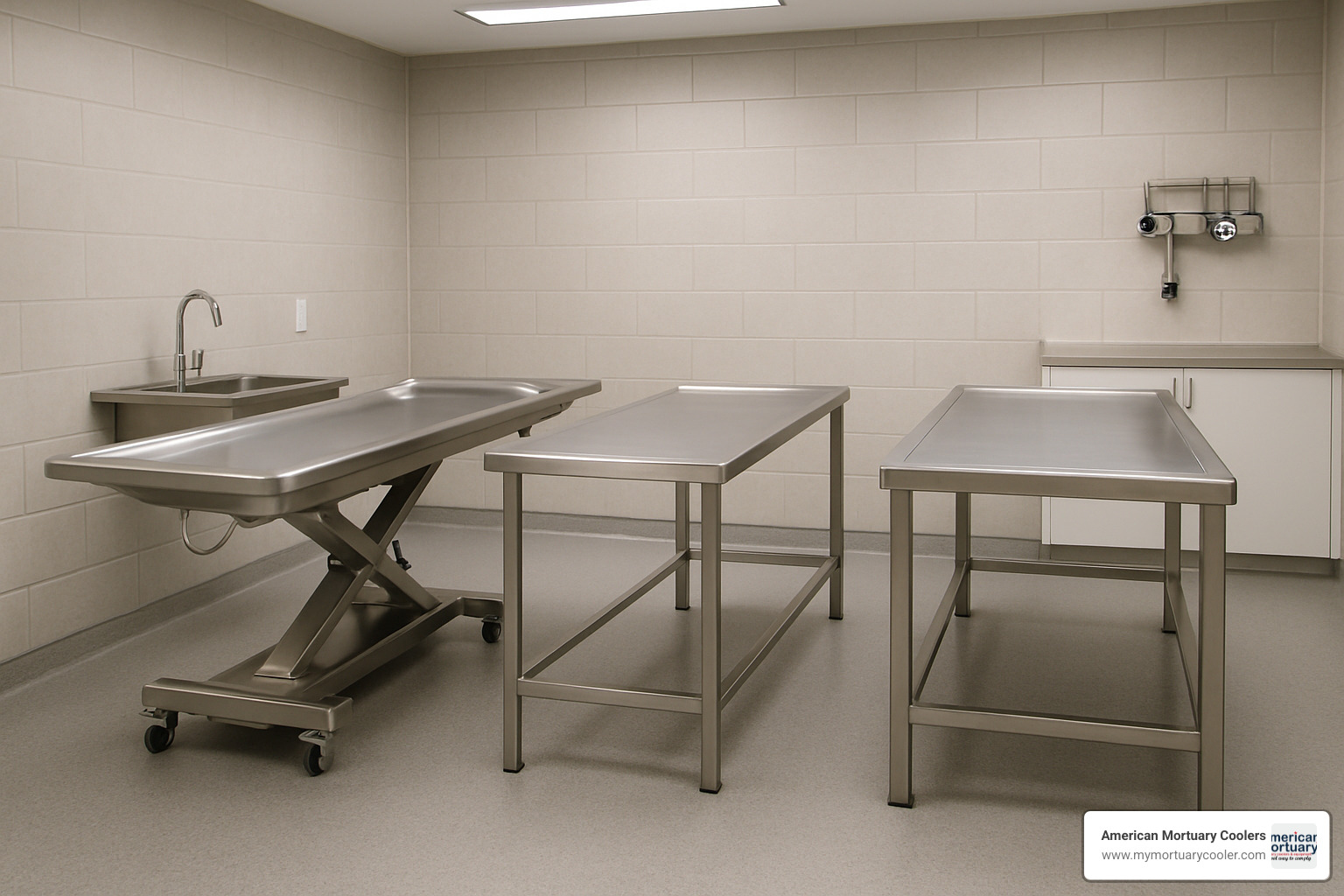
Hydraulic & Multi-Height Options
If you're looking for the Mercedes-Benz of embalming tables, hydraulic models are your answer. These premium tables make life easier on your back and your workflow with their three-pedal control systems that let you adjust up, down, and tilt with just a tap of your foot.
Most of our hydraulic tables at American Mortuary Coolers adjust from 30" to 38" in height—perfect for accommodating embalmers of different heights or for changing positions during those longer, more complex cases. They'll support up to 1,000 pounds and come with locking casters that keep the table rock-solid during procedures but allow easy movement when you need to reconfigure your space.
The medical-grade hydraulic systems in our tables are built to last, rated for more than 20,000 cycles. That means years of reliable, quiet operation—something your staff will appreciate during long days, and something families will never notice during religious washing ceremonies.
Multi-height tables offer similar benefits with a simpler approach. Instead of infinite adjustment, they typically offer 3-4 preset positions with a quick one-hand release mechanism. They generally support between 650-800 pounds and come with a more budget-friendly price tag while still saving your back during those long preparation sessions.
Folding & Dressing Tables
Not every funeral home has the luxury of a spacious prep room. That's where folding tables shine. These clever space-savers are built from lightweight aluminum or stainless steel, support around 600 pounds, and many fold down to just 8 inches thick when not in use.
I've seen these tables work wonders in smaller funeral homes where space is at a premium. They're also perfect for mobile teams or facilities that handle occasional embalming but don't need a permanent setup. When business picks up, they make excellent supplementary tables to handle the increased workload.
Many of our customers pair these tables with church trucks to create a smooth workflow for moving the deceased through each stage of preparation. While they may not have all the bells and whistles of permanent tables, quality folding models still include proper drainage systems and the sanitary surfaces you need.
Want to learn more about how versatile these tables can be? Check out more info about folding tables on our site.
Specialized Bariatric & Autopsy Units
As our population changes, so do the needs of funeral professionals. That's why we've developed specialized tables to address specific requirements.
Our bariatric embalming tables feature oversized decks (typically 40" wide compared to the standard 32-35"), reinforced frames that support well over 1,000 pounds, extra-wide drainage troughs for increased fluid volumes, and heavy-duty casters rated for higher weights. These thoughtful design elements ensure dignity for larger individuals and safety for your staff.
For those handling autopsy and specialized procedures, we offer tables with built-in scales for accurate weight measurement, perforated surfaces that improve drainage during autopsies, immersion dissection capabilities for specialized medical examinations, and bariatric autopsy trolleys that combine transport and examination functions.
Yes, these specialized units come with premium price tags—ranging from $10,000 to nearly $20,000 for fully-featured models—but they provide essential functionality that standard tables simply can't match. When you consider the safety of your staff, the dignity of the deceased, and the efficiency of your operations, many funeral directors find the investment well worth it.
At American Mortuary Coolers, we understand that choosing the right Prep Table Embalming equipment is about finding the perfect balance between your needs, space constraints, and budget. That's why we're always available to help you steer these important decisions with personalized guidance.
Critical Features & Specifications to Evaluate
When shopping for the perfect table for prep table embalming, you'll want to pay attention to several key features that can make or break your daily workflow:
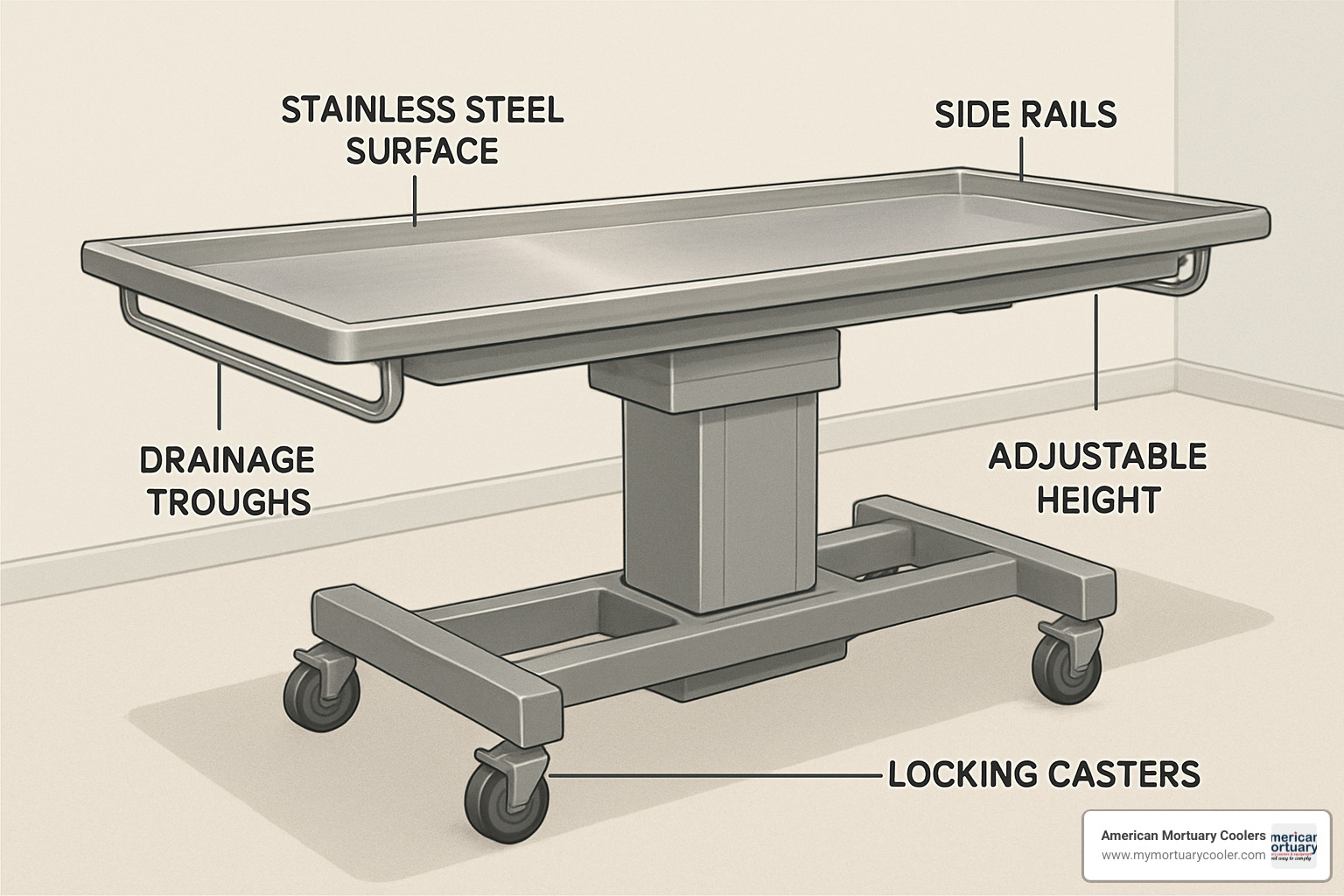
Material & Build Quality
Think of your embalming table as the workhorse of your prep room - it needs to withstand daily use, harsh chemicals, and constant cleaning. That's why material matters so much.
The gold standard is 304 stainless steel - and for good reason. This hospital-grade material stands up beautifully to the corrosive effects of bodily fluids and chemical disinfectants. We've seen tables made from lesser materials develop pitting and corrosion in just a few years, while properly maintained 304 stainless can look almost new for decades.
When examining tables, run your hand along the welds. Quality tables feature continuous welds that have been ground smooth, not spot welds that create tiny crevices where biological material can hide. These seemingly small details make a huge difference when you're sanitizing between cases.
The marine edge design is another feature worth its weight in gold. This raised lip around the perimeter prevents fluids from escaping the table surface - something your shoes (and your janitorial staff) will thank you for. At American Mortuary Coolers, we've refined our marine edge to be high enough to contain fluids but smooth enough not to interfere with your arm movements during procedures.
Ergonomics & Adjustability
After 25 years in this industry, I've seen too many embalmers develop back problems from working at poorly designed tables. Good ergonomics isn't a luxury - it's essential for your long-term health and career longevity.
The best tables offer height adjustability from about 30 inches (perfect for seated work) up to 38 inches (ideal for standing procedures). This range accommodates different practitioners and different tasks. Our hydraulic systems allow for smooth, quiet adjustments that won't disturb the dignity of the preparation process.
Tilting capabilities might seem like a fancy extra, but they're incredibly practical. A slight head-down tilt helps with drainage during arterial injection, while a head-up position can be invaluable during facial restoration work. One-hand release pedals let you make these adjustments without interrupting your workflow or compromising sterility.
Many embalmers find that padded floor mats, adjustable instrument trays, and foot-operated controls dramatically reduce fatigue during long procedures. These ergonomic add-ons might seem like small details, but they make a big difference during those long days when you're handling multiple cases back-to-back.
Accessory Compatibility & Instruments
Your embalming table doesn't work in isolation - it's the centerpiece of an integrated system of tools and accessories. Making sure everything works together seamlessly is key to an efficient prep table embalming process.
Body lifts need clear access to the table surface, so consider ceiling clearance and table positioning. Aspiration units require thoughtful placement of vacuum lines, while trocar racks should be positioned for easy reach without obstructing your workflow. Well-designed incision spreaders won't interfere with arterial tubes, and chemical-resistant pail liners make disposal safer and more efficient.
Most embalmers find that a 30-inch flat-bottom instrument tray provides the ideal balance of space and organization. Having your tools arranged logically saves precious time and reduces the mental load during complex procedures.
For a comprehensive selection of specialized instruments designed specifically for embalming, many professionals turn to resources like the Embalming Supply Company – Prep Room Instruments for industry-standard tools.
At American Mortuary Coolers, we design our tables with these accessory integrations in mind, ensuring that your entire prep room functions as a cohesive unit rather than a collection of disconnected pieces. After all, when you're focused on providing dignified care to the deceased and their families, the last thing you need is equipment that fights against you.
Workflow Integration, Safety & Compliance
Creating an effective Prep Table Embalming environment isn't just about having the right table—it's about how that table fits into your entire preparation room workflow while keeping everyone safe and meeting all those pesky (but important) regulations.
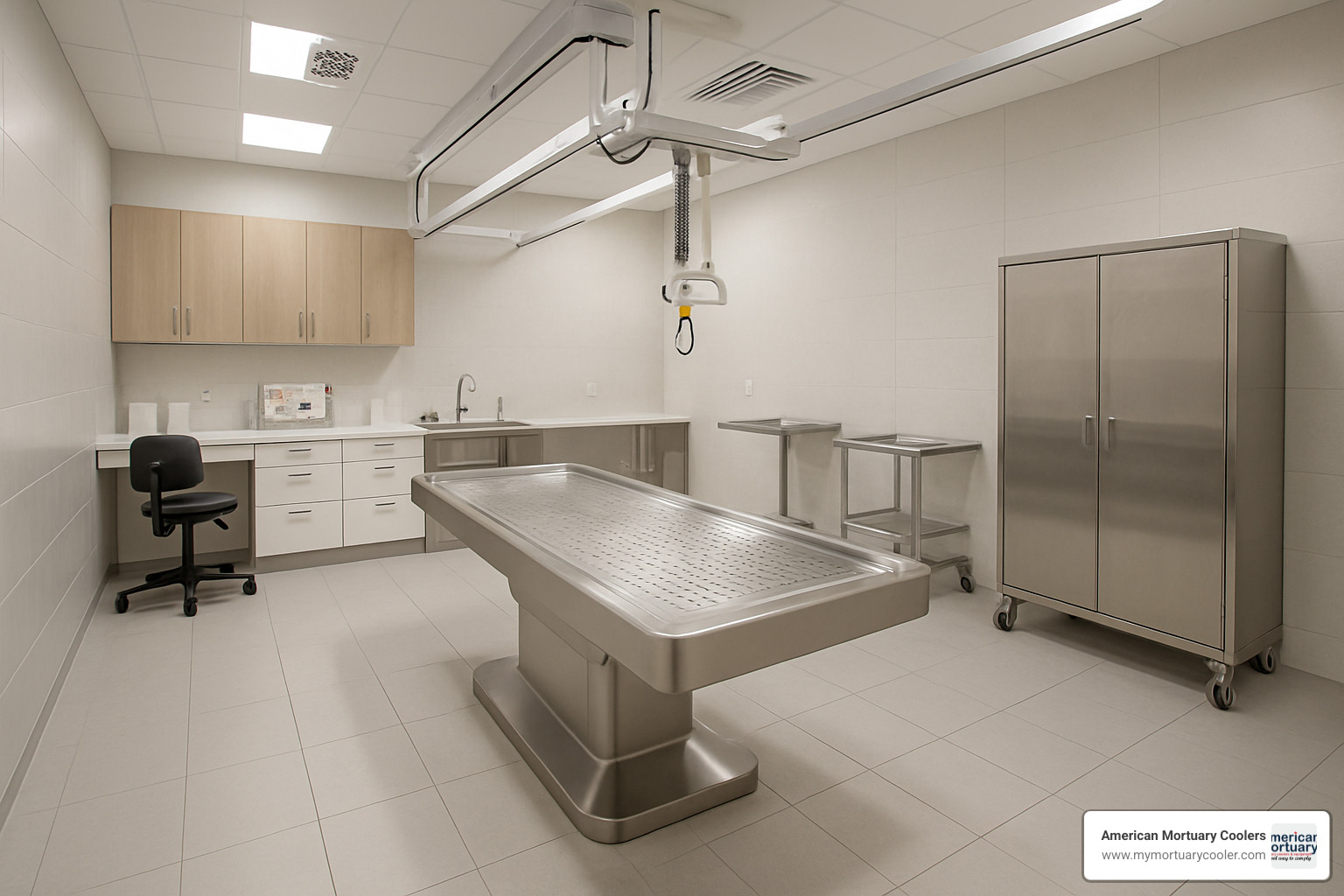
Prep Table Embalming and Room Design
Think of your prep room as a thoughtfully choreographed dance where everything has its place and purpose. The star of this show—your Prep Table Embalming station—needs to be positioned just right:
Your ceiling-mounted body lift rails should line up perfectly with your table, making transfers smooth and dignified rather than awkward shuffling. Nobody wants to play a game of "furniture Tetris" when moving a loved one from a stretcher to the prep table.
Keep your refrigeration units close by. I've visited too many facilities where staff members have to steer a maze just to transfer a body from cooler to table. Those extra steps add up over time—both in physical strain and wasted minutes.
Consider how your utility carts and instrument stations flow around the table. Ideally, you should be able to reach what you need without doing laps around the room. A well-designed space creates what we like to call a "conveyor-style workflow"—a logical progression from intake to refrigeration to preparation to dressing, with no backtracking.
Proper ventilation isn't just about comfort—it's essential safety. Your ventilation system (whether downdraft or side-draft) should capture fumes right at table level, keeping the air clean and compliant.
Here at American Mortuary Coolers, we don't just sell you equipment and wish you luck. We offer comprehensive prep room design services across all our service regions—from Johnson City TN to Atlanta GA, Chicago IL, and everywhere in between across the lower 48. We've helped hundreds of funeral homes create spaces that work smarter, not harder.
Regulatory Checklist & Best Practices
Let's talk about keeping on the right side of OSHA and state regulators (and keeping yourself healthy in the process). Formaldehyde exposure limits are set at 0.75 ppm over an 8-hour period—a number that matters for both compliance and your long-term wellbeing.
Your eye-wash station should be a quick 10-second dash from your embalming table—not across the building or down a hallway. When chemicals splash, seconds count.
Those lockable casters on your table aren't just a nice feature—they're a must-have to ensure stability during procedures. Nothing disrupts an embalming process like a shifting table.
All electrical connections near your Prep Table Embalming area need proper ground-fault protection through GFCI outlets. Water and electricity make dangerous partners in a prep room environment.
Keep sharps containers within arm's reach of your table. The last thing you want is to walk across the room carrying used instruments or needles.
Your table design should minimize splashing and aerosolization—those marine edges and deep troughs aren't just for show, they're keeping you safer.
Beyond the technical requirements, there's also the human element to consider. Many facilities now maintain dedicated tables for specific faith traditions or incorporate removable washboards for ritual washing ceremonies. The Soft-Prep method we mentioned earlier works wonderfully in medical training facilities where more natural tissue appearance and flexibility matter.
For those wanting to understand embalming tables in a way that's informative without being overwhelming, I recommend reading Understanding Embalming Tables Without Getting Creeped Out. It breaks down the technical aspects in a friendly, approachable way.
Maintenance, Sanitation & Cost of Ownership
Let's talk about what happens after you bring that shiny new embalming table home. The real value of your table isn't just in how it looks on day one—it's about how it performs for years to come.

I've seen too many funeral homes focus solely on the purchase price without considering the full picture. Think of your prep table like a car—the sticker price is just the beginning of the story. When you factor in cleaning time, maintenance costs, and expected lifespan, the numbers tell a different tale:
Comparison of Embalming Table Cost Factors:
| Table Type | Initial Cost | Annual Maintenance | Expected Lifespan | Daily Cleaning Time | Total 10-Year Cost |
|---|---|---|---|---|---|
| Basic Folding | $659-$2,500 | $50-$100 | 5-8 years | 10-15 minutes | $1,159-$3,500 |
| Mid-Range Fixed | $3,000-$7,000 | $100-$200 | 10-15 years | 15-20 minutes | $4,000-$9,000 |
| Premium Hydraulic | $8,000-$19,995 | $200-$400 | 15-20+ years | 15-25 minutes | $10,000-$24,000 |
Sanitizing Protocols
Let's be honest—cleaning isn't the glamorous part of funeral service, but it's absolutely essential. A properly sanitized prep table protects both your staff and the families you serve.
After each case, your Prep Table Embalming equipment needs a thorough rinse-down to remove visible biological material and chemical residues. This isn't just about appearances—it's about preventing cross-contamination and maintaining a safe workspace.
We recommend using only EPA-approved disinfectants registered specifically for bloodborne pathogens. One common mistake I see in prep rooms is not allowing enough contact time—these disinfectants need to sit on the surface for 10-30 minutes (check your product's label) to actually do their job.
Your stainless steel surfaces should remain smooth and unblemished. Any scratches or pitting can become tiny hiding places for bacteria and other nasties. That's why at American Mortuary Coolers, we finish our tables with a special polishing process that makes them more resistant to damage from daily use.
Don't forget about your instruments! Items like trocars should be completely immersed in sterilization solution between uses. And always use chemical-impervious bags for tissue disposal—the last thing you want is leakage creating cross-contamination issues.
Our recommended three-step cleaning approach is simple but effective: initial rinse to remove residue, application of hospital-grade disinfectant with proper dwell time, and a final clean water rinse. This method gives you maximum sanitation while protecting your stainless steel investment from chemical damage.
Budgeting for Prep Table Embalming Equipment
Smart financial planning for your Prep Table Embalming equipment goes beyond just finding the lowest price tag.
If you're outfitting an entire prep room, ask about bulk purchase discounts. We regularly work with new funeral homes to create package deals that can save thousands compared to buying pieces individually. Many suppliers (including us) offer financing options specifically designed for funeral industry equipment, making it easier to get the quality you need without breaking the bank.
Think about the total lifetime cost of ownership. That bargain table might seem like a deal until you're replacing it in five years, while a premium model could still be serving you beautifully after two decades. Quality stainless steel tables often retain significant resale value even after years of use—something to consider if you might upgrade or relocate in the future.
For facilities serving diverse communities, investing in adaptable tables that accommodate various cultural and religious requirements often makes more financial sense than maintaining separate specialized equipment. Similarly, a multi-function table that handles both embalming and dressing provides better value than single-purpose units.
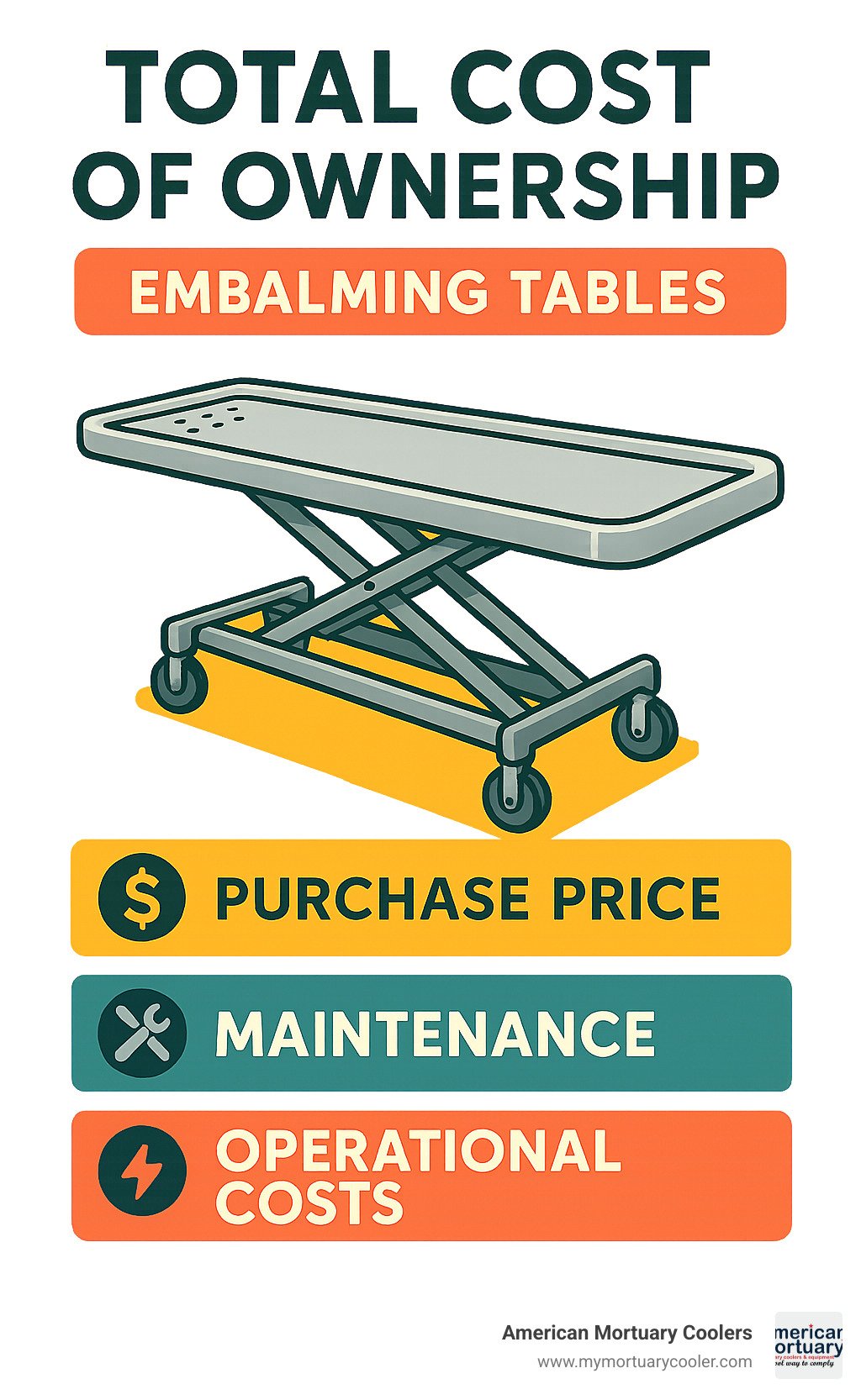
At American Mortuary Coolers, we've helped hundreds of funeral homes make smart, budget-conscious decisions about their prep room equipment. We understand that every dollar counts in this business, and we're committed to helping you find the right balance between quality, functionality, and affordability for your specific situation.
Conclusion & Quick-Fire FAQs
Finding the perfect equipment for Prep Table Embalming is more than just a purchase—it's an investment in your funeral home's efficiency and the respectful care you provide to families. At American Mortuary Coolers, we've worked with funeral homes of all sizes and understand that your facility has its own unique needs based on your available space, case volume, and the communities you serve.
We take pride in offering customized solutions for preparation rooms, from simple folding tables to sophisticated hydraulic systems. Every piece we manufacture meets exacting quality standards and ships directly to funeral homes throughout the contiguous 48 states from our locations in Johnson City TN, Atlanta GA, Chicago IL, and other regional distribution centers including Columbia SC, Dallas TX, Los Angeles, New York NY, and Pittsburgh PA.
When you're evaluating options for your Prep Table Embalming equipment, your table is the cornerstone of your preparation room workflow. The investment you make in quality construction, durability, and ergonomic design pays off in so many ways—from keeping your staff healthy and comfortable to improving procedural efficiency, and ultimately, enhancing the quality of service you provide to grieving families.
For those who want to dive even deeper into embalming table comparisons, I recommend checking out The Ultimate Guide to Comparing Embalming Tables.
FAQ 1: What size prep table fits a small prep room?
If you're working with limited space, you're not alone! Many funeral homes face this challenge. For smaller prep rooms, I typically recommend either a folding embalming table or a multi-height table with a smaller footprint. While standard tables usually measure about 32" × 80", we do offer more compact models as small as 30" × 76".
The key thing to remember is ensuring you have enough clearance—at least 30" on all sides—so your staff can move freely around the table and position accessories where needed. The beauty of folding models is that when you're not using them, they can be stored against a wall, freeing up valuable floor space for other activities or equipment.
FAQ 2: How often should prep tables be deep-cleaned?
While you'll want to sanitize your table after each use (that's a given!), I recommend a thorough deep-cleaning at least once a month. Think of it like maintenance for your car—regular attention prevents bigger problems down the road.
A proper deep-clean should include taking apart the drain components for a complete cleaning, checking under the table and all support structures, examining welds and seams to make sure everything's intact, lubricating any moving parts according to what your manufacturer recommends, and testing hydraulic systems under load to ensure they're working properly.
If your facility handles a high volume of cases, you might want to bump this up to every two weeks. And don't forget to document your cleaning procedures—it's not just good practice, it's important for regulatory compliance too!
FAQ 3: Can one table handle embalming, dressing, and transfer tasks?
Absolutely! Multi-function tables can be real workhorses in your preparation room. When shopping for a table that can do it all, look for features like hydraulic height adjustment (crucial for proper positioning during embalming), a flat surface option for dressing procedures, locking casters and handles for safe transfers, and a weight capacity of at least 650 lbs to handle various situations.
Yes, these combination tables typically cost about 15-20% more than single-purpose tables, but do the math—they can save you significantly on your overall equipment investment and space requirements. For smaller facilities handling 100 or fewer cases annually, a quality multi-function table is often the most cost-effective solution. Why buy three pieces of equipment when one well-designed table can meet all your needs?
For more details about finding your next embalming table, including specifications and customization options that might work for your unique situation, visit More info about purchasing your next table.



